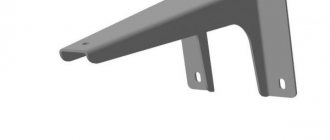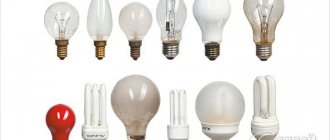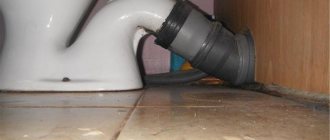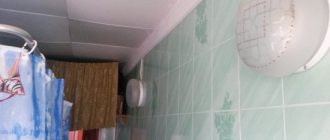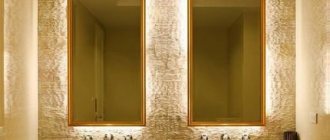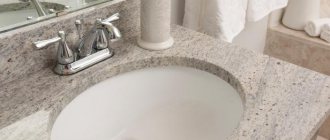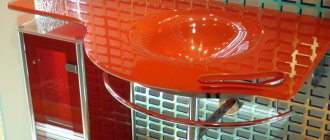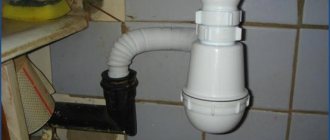Installing a sink in a bathroom is not at all difficult; even plumbers charge little for this work - the work is simple. But at the same time, this is a responsible matter - how you managed to install a sink in the bathroom directly affects not only the appearance of the room and the ease of use of the plumbing fixture, but also the sanitary and hygienic environment in your entire apartment.
If you remember, quite recently in our country the problem of choosing a sink suitable for your apartment did not exist. The same type of products were in almost every bathroom. Nowadays, the variety of these products allows you to create an interior that fully suits your taste, but at the same time, the wide selection poses many questions to the owner of the home.
Distinctive features of the tulip shell
A characteristic feature of the tulip model is its high, hollow pedestal leg, thanks to which the model takes on a resemblance to the flower from which it gets its name.
The support column not only gives the model an elegant look, but also performs a number of useful functions:
- The pedestal gives the structure the necessary rigidity, stability, and reliability.
- When there is mechanical stress on the bowl, the leg takes the load on itself, protecting the sink from damage.
- The hollow column allows service communications (water supply and drainage systems) to be hidden from view, making the room look neat and beautiful.
The pedestal, like the bowl, can have different decorative designs, resulting in a wide variety of models.
Image gallery
Photo from
Antique style tulip sink
Hidden communications liner
Fantasy design solutions
Sink model with half pedestal
Dimensions
Washbasins of this type can have various forms of washing:
- square;
- ellipsoid;
- semi-oval;
- round;
- semicircular;
- hexagonal;
- rectangular.
The standard “tulip” sample is usually made in the shape of a semi-oval or semicircle. The width of the sink on average can reach 60-65 centimeters. These parameters are determined without taking into account the side surfaces if the product is multifunctional. This range provides a wide range of washbasin models to choose from.
As for non-standard options, they can be both small and large sizes. Thus, a small-sized model can reach a maximum width of 50 centimeters, and a large-sized model can reach 90 centimeters. Non-standard washbasins of this size are much more difficult to find on the household appliances market.
If the bathroom area is average, it is not recommended to install a large sink, as it will take up a lot of additional space. There are many buildings with very small bathrooms; it is preferable to install sinks no larger than 40 centimeters in size. Such sinks are often called “office” sinks.
The traditional version of this type of sink is installed with a stand no more than 80 centimeters, while minor deviations from the standard are allowed. If we talk about sinks with a semi-pedestal, then the buyer himself can decide the optimal location of the sink from the floor.
The sink is undoubtedly the main interior detail in the bathroom. But in addition to its aesthetic qualities, it must be comfortable and functional. A tulip sink for a bathroom is the best option, since even classic designs have a stand that covers the communications, which also provides additional support for the sink itself.
Classification of washbasins with pedestal
There are several options for classifying shells of this type. The following characteristics can be used as a basis.
According to the way the sink is positioned
Based on the recommended installation location, two groups of sinks can be distinguished:
- Regular. The most common modification of the tulip sink, which is installed against the wall. A wide range of similar models allows you to choose an option that is ideal for any bathroom.
- Angular. As is clear from the name itself, these structures are designed for installation in the corner of the room. Such plumbing fixtures, which usually have small dimensions, allow rational use of usable space, ideal for arranging miniature bathrooms. We have provided more ideas on choosing a small sink here.
Corner models have an ergonomic design.
An ergonomic model of a corner washbasin with a pedestal, additionally equipped with functional cabinets, which allows optimal use of the usable space of the room
A corner washbasin cannot be installed structurally along a wall, while a straight model can easily be placed in a corner, fixed along one of the walls.
According to the design features of the models
Based on the characteristic design features, three main groups of washbasins can be distinguished:
- monolith;
- compact;
- half tulip
Monolithic models are a complete structure in which the sink is inextricably connected to the leg. Such options are quite rare in the consumer market: they are difficult to manufacture, which also affects the cost of such products.
Much more often on sale you can find washbasins of the “compact” type, consisting of two components: a sink bowl and a support column.
The advantages of these models include affordable price, practicality and ease of use. If, when the siphon is clogged, the monolithic model will have to be moved as a whole, then to eliminate this problem with a compact model, you just need to move the pedestal.
Modifications with a leg that does not reach the floor are called “half-tulip”. They have a more modest appearance, but have certain advantages.
Advantages of the third type of model:
- such products can be mounted at the desired height, which provides additional comfort during their operation;
- a half-tulip sink installed in the bathroom greatly facilitates cleaning the room, since the floor underneath remains completely free;
- the half-column, like a full-fledged pedestal, covers all communications well;
- This option is well suited for hanging plumbing fixtures, but in this case additional installation is required to firmly fix the model.
A washbasin with a half-pedestal will look great in a compact bathroom; it is also often used when decorating service spaces in offices or enterprises.
According to the material of manufacture
The material from which sinks are made affects the decorative and functional qualities of the models, as well as their cost.
Designer version of a porcelain tulip sink. This product can become a real decoration for a luxurious bathroom.
The most common options include the following:
- Faience. A common and affordable material that is often used to produce plumbing fixtures. Despite the budget price of earthenware tulip sinks, they have good performance properties, are quite strong and durable.
- Porcelain. A fairly expensive option is often used for the manufacture of designer models. Porcelain products that shine through in the sun have an exquisite, noble appearance, but in terms of consumer qualities they are close to earthenware structures.
- Acrylic. An artificial material with many useful qualities. Acrylic structures have a budget cost and are fairly light in weight; they are hygienic and impact resistant. In addition, this plastic can be easily processed (grinded, engraved) and painted, which allows you to create the most incredible versions of tulip shells. Disadvantages include some fragility (the material is easily scratched) and flammability.
- Stone. A strong and durable material that can be used to create impressive washbasin options. Most often, granite and marble or more affordable artificial stone are used for this. In addition to the high cost, the main disadvantage of such models is their heavy weight: it not only makes manipulation difficult, but also puts a large load on the floor. We recommend that you familiarize yourself with stone sinks in more detail.
In addition to the options listed above, there are tulip sinks made of glass, various types of plastics and other materials.
In addition, tulip shells vary in size. Typical options are models with bowl sizes of 50-70 cm, however, miniature and large-sized modifications are also available.
The best manufacturers
The brand of plumbing fixtures is of decisive importance for most consumers, because well-known manufacturers value their reputation and produce high-quality products, regardless of the price category. Each company has a line of quite budget models, plumbing fixtures in the mid-price segment and luxury ones, so choosing the best option is not difficult. So, whose products are in greatest demand?
The leading position is held by the Spanish. It produces not only plumbing fixtures, but also everything needed for a bathroom - moisture-resistant lamps, mirrors, accessories, furniture and much more. Since the company also has enterprises in Russia, the cost of production is much lower than that of imported plumbing fixtures. Tulip sinks are present in several collections of this brand, which include models with a pedestal and half-pedestal, as well as corner ones. All sinks are made of porcelain and earthenware and have a predominantly classic design.
shell tulip
Tulip sinks from Jacob Delafon, a French brand with a long history, are also in great demand. They are represented by several collections: Presquile, Odeon Up, Patio, Reve. The models are distinguished by regular geometric shapes; the design is dominated by the ideas of classics and cubism. The range includes standard and corner washbasins, with pedestal and semi-pedestal. Earthenware and porcelain are used to make sanitary ware.
The Swedish company Gustavsberg is also among the leaders. Its plumbing products are of impeccable quality and sell well both in Scandinavia and abroad, including in Russia. Porcelain sinks have an ergonomic shape and laconic design; models with pedestals are presented in two collections - Gustavsberg ARTic and Gustavsberg Nordic.
The Czech company Jika has very reasonable prices for high-quality plumbing fixtures. The products of this brand are in great demand in European countries, and Russian consumers also liked them. The author's collections include not only standard models, but also sinks for the disabled (Mio collection), as well as children's washbasins from the Baby series. Products are made mainly from earthenware; classical forms predominate in the design.
There are decent products made domestically. Rosa brand sanitary ware, owned by Kirov Ceramics JSC, is distinguished by its high quality and affordable price. Among Russian manufacturers, this company is rightfully considered one of the leaders in the plumbing industry. Tulip sinks are present in several collections and are distinguished by a variety of colors. In addition to the classic models, there are options in blue, black, green and other shades.
Oskol Ceramics is another brand whose plumbing fixtures fully comply with international standards. The production was founded by an Italian company in the city of Stary Oskol; products are manufactured using the latest imported equipment. Most of the products belong to the middle price segment; there is a large selection of economy class models. Tulip sinks are represented by the “Prestige” series, which, in addition to classic white washbasins, includes options in rich colors - red, blue, green, black and others.
Popular models of tulip shells
| Sink brand and model | Description |
| Semi-recessed rectangular bowl with a pedestal in the form of a round column. Made of earthenware, dimensions 63x51 cm. The design of the model is made in retro style, the design is symmetrical with a smooth glossy surface. Manufacturer's warranty 10 years | |
| The sink is built into the countertop, has a symmetrical shape, dimensions 100x46 cm. White color, made in a modern style, made of earthenware. Available in two versions - with a pedestal and a semi-pedestal. 10 year warranty | |
| Round hanging porcelain sink. Available in two modifications - with a pedestal and a half-pedestal, it has dimensions of 60x47.5 cm. The sink body has 1 ready-made hole for the tap and 2 planned ones, which you can cut yourself if necessary. Manufacturer's warranty 25 years | |
| Hanging model with a semicircular bowl, made of porcelain. Available in two modifications, dimensions 60x45 cm, equipped with an overflow. The sink is symmetrical, white, made in a modern style. 25 year warranty | |
| Compact model with a semicircular bowl, size 55x47 cm. Made in a modern style, distinguished by original colors. The sink is equipped with an overflow function and has one hole for the mixer. 5 year warranty | |
| Oskol ceramics. "Prestige", green | A very impressive model with a semicircular bowl. The size of the sink is 63.5x46 cm, the material of manufacture is porcelain. Made in a modern style, has a rich dark green color and a glossy finish. Manufacturer's warranty 5 years |
It is also worth noting the Italian-made Cezares plumbing fixtures, the Finnish-Ukrainian Colombo, the Czech Ravak, and the Bulgarian Vidima. The sinks of these brands have a lot of positive reviews, and the quality of the products has long been time-tested.
Pros and cons of tulip sinks
Washbasins with a pedestal have a large number of important advantages:
- Large range of models . There are various modifications on sale that differ not only in design features, but also in design, color, and size. Thanks to this, you can always choose an option suitable for interiors of different stylistic orientations.
- Affordable price. The cost of a “tulip” mainly depends on the material from which it is made. However, other things being equal, the price for a washbasin of this type is slightly lower than for other models (for example, “Moidodyr”).
- Compact design. Even conventional modifications have relatively small dimensions, which allows them to be installed in fairly compact spaces. In addition, there are miniature models - corner tulip sinks and options with a semi-pedestal. At the same time, even small-sized structures can effectively hide service communications (water supply and sewer systems) from view.
The tulip sink is practically free of flaws. Some inconvenience can be considered the inability to use the space under the washbasin (for example, under bedside tables).
However, there are models that provide additional cabinets and shelves that are attached to the column.
Compared to other types of plumbing fixtures, the installation work of a washbasin with a pedestal is quite easy. It is only important to attach the bowl to the wall, as well as correctly assemble the mixer and siphon. All this can be done with your own hands without the involvement of specialists.
You should also take into account the features of models made from different types of materials (porcelain structures are fragile, stone structures are heavy, and so on).
Installing a Tulip washbasin
The design is simple and does not include complex elements. Therefore, installing a tulip sink in the bathroom will not be difficult; it does not require any special professional knowledge or skills. Let's describe everything in order.
First of all, we need to prepare the tools that we will need. These are a screwdriver, keys, a drill, and if you have a drill, a hammer, plugs, a level and a dowel.
After everything you need is ready, we proceed to marking the place where we will make holes in the wall. Please note that they must fit neatly into the holes in the pedestal. Using the holes made, fasteners for the tulip sink will be made.
After this, we attach the siphon to the rack with bolts. A mesh with a special gasket is attached to the underside of the siphon. In this case, it is necessary to achieve a high degree of tightness.
The next step is to install the tulip bowl itself, which is done on the coupling bolts. And then we mount the pedestal in the center of the bowl. Don't forget about the siphon hose outlet. This corrugated hose is routed into the drain pipe using a special technique.
After the bowl and pedestal are installed, we proceed to fixing the entire structure to the wall. Fixation and final fastening is carried out using washers and bolts.
To achieve the tightest possible connection between the Tulip sink and the wall, and also to minimize the possibility of leaks, you can treat all joints with transparent silicone sealant.
And the final stage of installation is connecting the mixer to the sewer pipe system. If you follow these instructions and do everything correctly, installation will not take you much time.
Tips for choosing pedestal sanitary ware
When choosing a model, it is important to pay attention to the following factors:
- Height of the support column. Its length should be such that a person does not have to bend over much when washing. The typical size is 70-80 cm; if it doesn’t fit, it’s better to look for another model or settle on a tulip sink with a half-pedestal. In another article, we looked in detail at sink installation height standards.
- The size and depth of the bowl. The optimal option is a sink with a width of 55-65 cm. A large modification will take up a lot of space, and from a smaller version, splashes will scatter to the sides during washing. It is also not very convenient to wash from a very shallow bowl; it is better to choose a deeper sink. We talked about the size of the sink in more detail in this material.
- Holes for mixer. Depending on your preferences, you can choose a model that provides one modern mixer or separate axle-box taps for hot and cold water.
- Presence of overflow. This function allows you to avoid flooding in the bathroom if the outlet is clogged. You just need to remember that overflow requires a special siphon and an additional non-standard pipe.
- Accessories. Since pedestal sinks typically do not include a drain fixture, you will likely have to purchase one specifically. It is better to immediately select a tulip sink, siphon and faucet manufactured by the same company.
- Correspondence of the size of the washbasin to service communications. If a tulip sink is purchased to be installed in the bathroom after a major renovation with the replacement of water and sewer pipes, absolutely any option will do. When choosing a vanity to replace your previous plumbing, it is important that it matches the remaining plumbing systems.
Before going to the store, it is advisable to measure and write down the distance from the floor to the water supply pipes and other communication parameters.
Unfortunately, the discrepancy between the pins provided on the model and the existing wiring is very difficult, and often impossible, to correct. In this case, it is better to return the unsuitable model back to the store.
Before installing a tulip sink, it is important to carefully study the diagram of a specific model, which may have different sizes and design features.
After purchasing, do not forget to check the availability of all parts of the kit, and only then proceed with the installation of the washbasin.
What to consider when buying a washbasin
When going for a sink, you need to know exactly what type of sink you need. In addition, you need to know the permissible dimensions of the device and what height of installation of the washbasin is required, for which you need to measure the space in the bathroom where it will stand. Almost any bowl shape is suitable; the optimal length should be at least 55 cm, otherwise during use water will splash around the room. These products are produced with holes for the faucet and blind ones; for this reason, the method of installing the faucet and the appropriate size of the washbasin for the bathroom must be calculated in advance. It is better to purchase it at the same time as the sink in order to immediately test their compatibility. In addition, do not forget about the compliance of the fastening elements of the device and the plumbing system.
Features of installing a sink with a semi-pedestal
Installation of the compact model of this modification is carried out similarly to a regular tulip sink, but has some features:
- First of all, you should correctly select the optimal height for attaching the bowl. The standard parameter is 75-80 cm, but it is better to take into account the convenience of using the washstand.
- According to the instructions above, holes are drilled in the wall, dowels are inserted and the brackets on which the bowl is suspended are secured.
- After this, the standard procedure for connecting the mixer and siphon to the communication systems is carried out.
- Additionally, markings are made for fastening the semi-pedestal; You also need to make holes in the lower part of the structure, hammer in dowels and secure this part so that it covers the pipes.
The difference in installing a half-tulip lies in the last point, since the sink leg, which does not reach the floor, cannot provide the structure with the necessary strength and stability.
To install an attractive “half-tulip” model, which will fit perfectly into a small bathroom, you need to attach not only the bowl, but also the truncated leg to the wall
Types and methods of installation
The installation method of this plumbing fixture directly depends on its type. The most common ones include:
- Wall-hung or console washbasin – mounted to the wall on brackets. The shape and dimensions of the device can vary greatly, but it is easy to install. But there is a significant drawback - communications remain visible;
- Built-in sink - installed in the countertop. The design hides all unsightly communications and makes it possible to use furniture with a built-in sink for storing small items. True, such a design takes up a lot of space;
- “Tulip” (with a pedestal) - is distinguished by a special pedestal on which a bowl is installed, attractive in appearance and allowing to hide communications, which led to the popularity of this model;
- Bathroom sink with a semi-pedestal - for such products the pedestal is placed against the wall and requires a sewer pipe to be supplied at a certain height.
Typical mistakes when installing a structure
In order not to disrupt the performance of the equipment during installation, we will consider what mistakes you should be wary of.
The defects that are often encountered when installing a tulip sink yourself include the following defects:
- Sink tilt. If you mark the wall and install fasteners without checking the level, the bowl may not be hung level. A sink skewed to one side, of course, will not decorate the bathroom too much. Correcting this defect is quite difficult: you will have to re-dismantle all the parts and drill the holes again, carefully checking with a level.
- The gap between the bowl and the wall. The edge of the washbasin should fit snugly against the wall or partition. If there is even a small free space between them, water will constantly flow into it, which sooner or later will affect the safety of the wall. To avoid this, after installing the structure, you need to carefully seal all cracks and gaps.
- Plumbing or sewer leak. A water or sewer leak can have serious consequences, including flooding of an apartment (yours or your neighbors’). Most often it happens due to poorly tightened threaded connections. After performing such operations, you need to check the connections by giving water under high pressure.
- "Moving" of the shell. The reason for the instability of the bowl of a tulip sink can be loose bolts or an uneven floor under the pedestal. In the first case, the problem can be solved quite easily: you just need to check and secure all the connections of the parts. Things are somewhat more complicated if a second reason is identified.
You can temporarily correct the situation by placing suitable gaskets under the washbasin leg (preferably silicone ones that do not stick out from under the structure).
For large uneven areas, it is better to level the floor using a cement mixture.
There are other installation instructions on our website that cover the process of installing a pedestal sink.
The main stages of work on the correct installation of a washbasin
Due to the absence of complexities in the design of such a washbasin, special knowledge and skills for its installation are not required. Additionally, you can watch a video on how to install a tulip sink, which is offered after the detailed instructions.
- Firstly, to install the tulip yourself, you will need a hammer, screwdriver, wrenches, level, drill or drill, dowel, spacer plugs.
- Secondly, it is important to correctly determine the locations for the holes in the wall, which must clearly coincide with the holes for the tie bolts in the sink. To do this, just place the sink against the wall and take the correct measurements, and then take the drill.
- Next, a siphon is hermetically fastened to the drain of the washbasin bowl with bolts, in which a mesh with a gasket is fixed on the reverse side. This video of installing a tulip sink with your own hands will help you learn some details in more detail.
- The tulip bowl is lightly screwed to the wall using the coupling bolts, without tightening it, and a pedestal is attached under the central part of it. Here it is important to remember about the outlet of the corrugated siphon hose into the sewer drain pipe through a special opening at the bottom of the stand.
- Then the correctly installed pedestal with the bowl is tightly fixed to the wall using bolts and washers. The joints of the bowl and pedestal, the joints of the sink and the wall can be treated with a special silicone transparent sealant to prevent water from entering them.
- The final stage of work will be the simple connection of the mixer to the water pipes.
Carefully and consistently done work on installing the tulip yourself will not only transform the bathroom, but also save on the services of a locksmith.
Tulip - sink on a pedestal
Recently, flower-shaped washbasins have become quite common.
In addition to the usual bowl, the tulip sink has a stand.
That is, the bowl stands on a leg.
That is why it has such a name.
Its general appearance resembles a flower.
The stand is made of the same material as the bowl.
This is usually ceramic. Usually the products are made in one piece.
In some varieties, you need to connect the sink and stand together independently. The tulip washbasin has an elegant appearance, which is why it is quite popular.
This design is very durable and can last up to 20 years. Ceramics are not afraid of moisture. This type of sink hides all plumbing connections well.
For example, a siphon or pipes. Therefore, the bathroom takes on an aesthetic appearance with the presence of such an accessory. The height of the washbasin is no more than 85 centimeters.
This is very convenient, especially when there are small children in the house. They can easily reach the sink on their own and wash their hands. An excellent option for a small bathroom would be a tulip corner sink.
It will not take up much space and will help save space. This type of sink has virtually no disadvantages, except that it requires a little more space than a regular sink.
Conclusions and useful video on the topic
In the video below you can clearly see how to install the sink.
As you can see, having the available tools at hand, installing the “tulip” is quite easy. With a little effort and time, your bathroom will be decorated with an elegant washbasin that resembles the head of a beautiful flower. .
Do you have experience installing a tulip in your bathroom? Or are you a professional plumbing installer and want to share useful tips with beginners? Leave your comments in the block below this article - many home craftsmen will be grateful to you.
Or maybe you are just figuring out the process of installing a sink and you still have some unclear points? Don't hesitate to ask questions - we will try to help you.
Installation procedure
Some craftsmen are wondering how to install a tulip sink in the bathroom. This procedure does not require special knowledge or skills.
The main thing here is to adhere to a certain scheme of actions:
- The first thing to do is prepare the tool. Here you will need: a screwdriver, a wrench, a hammer, a drill, a level, dowels and spacer plugs.
- Next you need to find a place to fix the bolts. To do this, the accessory is applied to the surface and marks are made through the holes. Only after accurately determining the location can you take up the drill.
- You need to attach a siphon to the drain of the tulip bowl in advance.
- The sink is attached to the wall; the bolts should not be tightened immediately, just tighten them. A pedestal or leg needs to be attached to the center of the bowl. The main thing here is not to forget about the output of the corrugated drain hose. In simple words, draining is done.
- After everything is set up, you should start attaching the accessory. To do this, the bolts must be tightened.
- It is better to immediately coat the joints between the washbasin and the wall with a special transparent sealant. This will help prevent water and moisture from getting there. This will prevent the formation of fungus in the future.
- And the last step is installing the mixer. Usually this does not present any difficulties.
After installation is completed, you must immediately check the accessory for leaks. To do this, you can plug the drain and fill it with water. A properly installed washbasin will add comfort to your bathroom.
The video shows the installation of a sink with a pedestal:
Advantages
The tulip has quite a lot of advantages over other types of these plumbing products.
First of all, there is a large selection of materials and shapes, as well as colors. You can find the perfect tulip sink for almost any bathroom interior, be it retro or modern modern. In addition, I am very pleased with the very affordable pricing policy, because a person with any income can purchase such a washbasin in any hardware store, since this model is very common.
Well, naturally, the main advantage of this model is its decorative function, thanks to which all pipes connected to the sink during installation are closed, but at the same time, this does not make it difficult to access them if necessary.
Another important criterion in favor of choosing this sink is the ease of installing it yourself.

